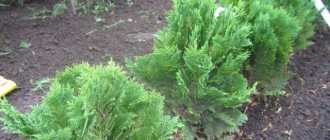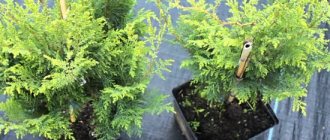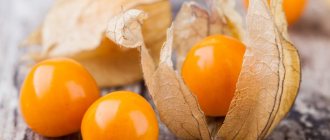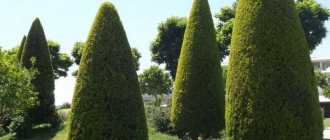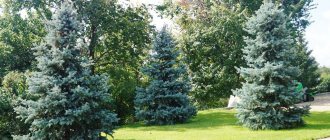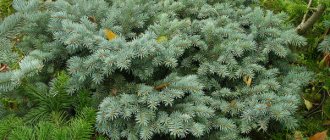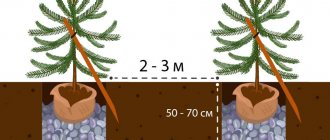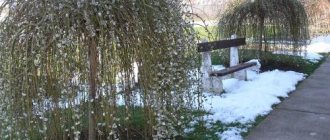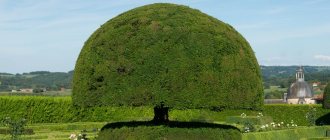Where does cypress grow?
Origin of cypress, history, where it grows.
Read the article about cypress - can you grow it in your garden? Where does cypress grow?
An evergreen plant of the Cypress , pine family - a popular family for lovers of greenery, supple and lush crowns and an indescribably refined, soothing smell. If you are still wondering whether to plant cypress on your property, then the answer is, without a doubt, yes!
Where does cypress grow:
- Homeland - North America.
- Distributed in California, Guatemala.
- Habitat: Northern Hemisphere.
Cypress can be found in countries such as China and America , as well as in the territories of the Caucasus and Crimea, but do not overlook cypress plants in Lebanon and Syria, or in the highlands of the Himalayas.
Studying the natural habitat, you can notice that cypress prefers poor soils - slightly saline, loose, rocky soil . It can easily tolerate droughts without losing its green attractiveness. Cypress grows individually or in groups, but in the garden plot the summer resident decides how to arrange the planting, so combinations of 3 or 6 small trees in a ring, diagonal planting, or around central objects, alleys, and recreation areas are popular.
Reviews on caring for cypress at home
Reviews from indoor plant lovers help correct or avoid repeating common mistakes. Most often, they experience difficulties due to dry air in the room and temperature disturbances (especially in winter):
Svetlana, florist: “This cypress tree has been living in my kitchen for 9 months. Near the window in winter it is cool, light (without bright rays), sometimes fresh air comes in. I water it carefully and spray it. I bought it before the New Year and successfully transplanted it in February. He has grown well – by 7-8 cm.”
Olesya, amateur gardener: “I put the donated cypress tree on the windowsill and watered it like other plants, but it began to dry out. It turned out that I did not maintain normal temperature and lighting. I transplanted it into a new pot and provided good humidity with the help of a bag. It's become greener."
Vyacheslav, pensioner: “I provide all living conditions. It grows slowly, but does not wither. I'm worried about the transplant. I know that the plant does not always tolerate this procedure well.”
Natalya, experimental florist: “It is very difficult to ensure normal wintering in apartments with good central heating. My “ward” lost its decorativeness by spring.”
Angelina, owner of 3 cypress trees: “Actually, caring for my pets is not difficult. The main thing is to water it in a timely manner, immersing it in water for about 10 minutes and keeping it on a cold windowsill.”
Is it possible to grow cypress at home?
At home, the tree feels good up to a certain age, but it will require replanting to stimulate the development of the root system.
What you need to worry about when growing cypress at home : do not place it near radiators, place it away from heating appliances - the same for fireplaces, moderately moisten the earthen ball, choose the right area for placement.
Where does cypress grow at home : near the eastern windows, in the northern zone of the room.
Soil mixture for planting cypress : peat + sand + leaf soil + turf in equal proportions.
Planting cypress: choosing a location and preparing the soil
Cypress does not tolerate direct sunlight, and in the shade it stretches out greatly, so areas in partial shade will be ideal for its growth. It does not tolerate waterlogging, but needs frequent watering, so it is better to choose soils with good ability to drain excess moisture. Otherwise, each species has its own specific requirements for growing and care conditions.
When preparing a hole for planting, it is advisable to use a substrate of soil and pine humus. An alternative is a mixture of peat, sand, turf and rotted leaf litter. Cypress trees react painfully to being transplanted to a new place, so the seedlings are transferred along with a lump of earth. After planting, the young stem is tied to a pre-driven peg.
Evergreen cypress – Cupressus sempervirens
Cypress - the scent of the Mediterranean
Cypress became very widespread and culturally valuable in the Mediterranean , as gardeners associate it with a light sea breeze near mountainous areas, and not with the hot urban thickets of California.
It is the evergreen type of cypress, which is also distinguished by its increased resistance to frost, that has spread from the coast further to the east - planting and growing it in our area from seeds or cuttings is much more convenient than large-fruited or Arizona.
Features of the development of evergreen cypress:
- Reaches 25-30 m in height.
- Forms a crown in the form of a pyramid.
- The branches are scaly and tightly adjacent.
- Colour: deep green.
- Forms cones - brownish tint.
- 1 cone = 20 seeds.
Where does evergreen cypress grow : in a well-lit place, with loose soil, tolerates cold and is resistant to winter frosts, but needs to be covered and illuminated. Loves spring and summer ventilation if located at home. It is formed at a temperature of +10-25° C - no higher is necessary. Air humidity is high, so it is not against spraying.
Watering and fertilizing cypress:
- Moisturize once a week. Check the soil and vary the frequency depending on the condition.
- Do not fill when the temperature drops/increases.
- Start feeding in May - once a month based on mineral components.
It is recommended to carry out foliar spraying throughout the summer to maintain the green mass of the tree. Use diluted trace elements and minerals in water, or the drug "Epin".
↓ Write in the comments where does your cypress grow?
Please rate the material you read :)
Types and varieties
Currently, flora lovers can grow in their garden, as well as indoors, any of the varieties or types of cypress, of which there are a large number.

Pyramidal
This variety of coniferous plant, whose homeland is the Eastern Mediterranean. Pyramid cypress is also called Italian. The tree is characterized by a wide crown in the form of a column and a height of about 35 meters. The plant grows to this size in approximately 100 years. The original form of cypress was obtained thanks to the work of breeders. This long-liver is characterized by good frost resistance; it tolerates frost of 20 degrees.
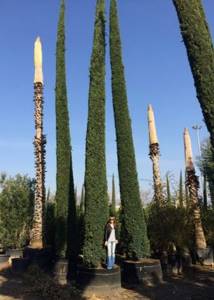
The ideal place for the life of a pyramidal species is a hilly area. The plant has a positive attitude towards mountains and poor soils. The tree is covered with small needles, which are colored emerald. The formation of cones occurs on small branches that are colored brown. The growth of a young individual is faster than that of an adult. After reaching 100 years, the pyramidal cypress stops growing. This plant serves as an excellent decoration for country houses, alleys, and park areas.
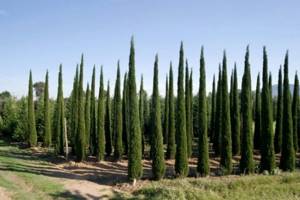
Arizonan
The Arizona cypress tree is native to Mexico, Arizona. A representative that lives in its natural environment grows on mountain slopes. Even 20 years ago, this beautiful plant began to be grown in private plots, parks and gardens. Representatives of this family are characterized by a long lifespan, which in some cases reaches 500 years. During this time, the tree grows up to 2000 centimeters. The bark of representatives of this species is gray, but turns brown over time. Arizona cypress wood is similar to walnut, it has high hardness and low weight. The tree can tolerate drought and frost, and grows quite quickly.
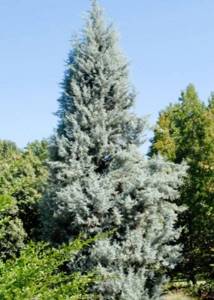
Evergreen
Evergreen cypress is also called common cypress; the shape of this tree resembles a pyramid. The narrow crown of the plant is formed by short branches that fit tightly to the trunk. The common cypress is cone-shaped and can grow up to 3000 centimeters. The needles are small, elongated, scaly, they are pressed tightly against the branches in a cross-shaped manner. The cones hang from short shoots and are characterized by a diameter of 30 mm.
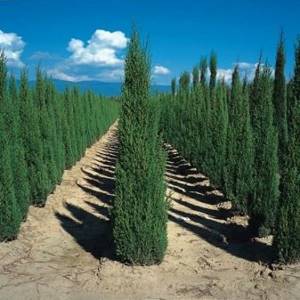
This type of plant is characterized by rapid growth. Lovers of green spaces can also encounter common cypress with red needles. It prefers shaded areas and survives at temperatures as low as minus 20 degrees. The tree is not picky about soil, and the possible presence of stones in the soil will not interfere with its growth.
Excessive moisture has a detrimental effect on wood. This representative of the flora is a long-liver; it begins to produce cones at the age of 5 years. This type of cypress is trimmed for decorative purposes. Neatly trimmed trees serve as an excellent decoration for the area.
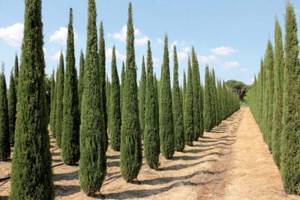
Cypress pea
Pea cypress is an unpretentious tree plant native to the Japanese Islands. It is resistant to frost and thrives in damp soils. It grows very slowly, in 10 years it stretches only 40 cm. The tree has a branched crown in the shape of a wide cone, formed by horizontally growing branches. It has beautiful gray-blue needles.
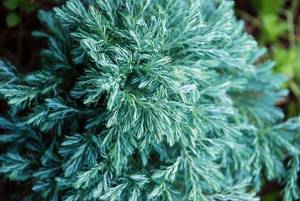
The most popular varieties of the cypress genus are:
- Boulevard - blue cypress. This is a low tree, up to 5 meters high. The crown has a shape reminiscent of a pin. It is distinguished by silver-blue needles with awl-shaped, curved needles. Loves good lighting and moist soil. It grows better in the southern regions, where there are no severe frosts, and is not frost-resistant.
- Filifera nana (Filifera nana) cypress is a fluffy shrub with a spherical crown that does not require shaping. Grows well both indoors and outdoors under mild climate conditions. It has a long lifespan - up to 300 years. Belongs to dwarf varieties - an adult plant does not exceed 50 cm.
- Filifera Gracil or filamentous is a tall shrub reaching 5 meters. It has a weeping crown of a conical shape - its thin, drooping branches look like long threads. The needles are dark green, scaly. Very frost-resistant.
This is interesting: Methods of propagating barberry: by cuttings, how to propagate by layering and seeds
Swamp cypress (Taxodium distichum)
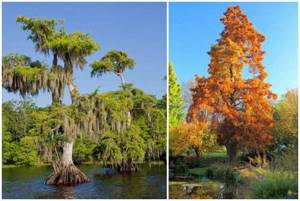
Taxodium distichum has another name - taxonium biserialis. This is an amazing plant.
Wild specimens reach colossal sizes: about 36 meters high, and the trunk diameter is 1 – 3 meters. Individual trees were observed whose trunk diameter was 5 meters.
A significant difference from other species is that it is deciduous. Thick, ten-centimeter bark, red-brown in color, furrowed with longitudinal cracks.
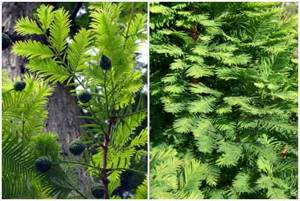
Taxonium is two-rowed, prefers moist, marshy places. This species has root outgrowths - pneumatophores, shown in the photo below. They help the tree breathe during flooding. The outgrowths can rise above 1 - 2 meters above the ground and have a cone-shaped shape. It is interesting that pneumatophores are not always formed, but only if there is swampiness.
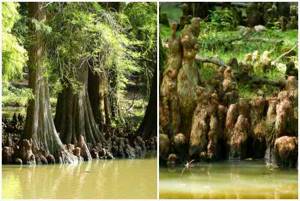
Large-fruited cypress (Cupressus macrocarpa)
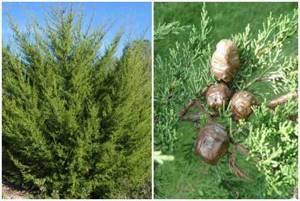
This species grows faster than its predecessors and is resistant to sea winds. Therefore, it is used for forest shelterbelts, planted near the banks. The root system is powerful, requiring a greater depth of fertile soil.
Citric
Lemon cypress is an indoor plant; it is distinguished by a pleasant pine-lemon aroma and elongated shape. The flower is quite beautiful, but whimsical. The needles of the ornamental plant are colored light green. The plant is characterized by drought resistance and an unpretentious attitude towards the soil. Lemon cypress grows slowly, but lives long.
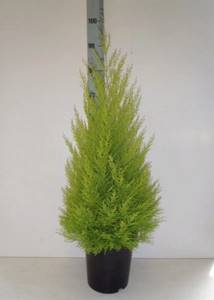
Goldcrest Wilma
This variety of evergreen survives better than others at home. It looks like a miniature Christmas tree, which is covered with narrow leaves. The color of the shoots is light green, sometimes even yellow. The small scaly leaves emit a lemony scent. This flower is popular in apartments and office spaces due to its attractive appearance and unpretentiousness. "Goldcrest Wilma" prefers diffused lighting, too much of which can cause needles to fall off. A favorable temperature for the plant is considered moderate; if it exceeds 27 degrees, the plant dries out. To make the cypress crown look well-groomed, it should be trimmed; this process stimulates the growth of new branches.
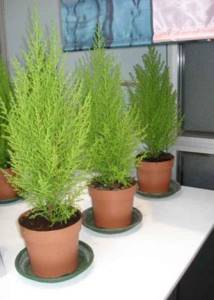
Dwarf
The dwarf cypress is a tree with a pyramidal crown, it is quite similar to the thuja. The bark of the tree is brownish-brown in color and is covered with scales and cracks. The branches can be either drooping or spreading. The shoots of the plant are flattened. The needles of the dwarf cypress are opposite and arranged crosswise. Young individuals are covered with needle-shaped needles. Male cones are oval-shaped and small in size, while female cones are round and covered with scales.
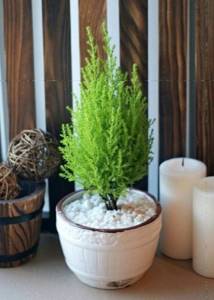
Description of swamp cypress
Swamp cypress (Taxodium birowdum) is a deciduous coniferous tree belonging to the Cypress family. Its height reaches 30-36 meters, the thickness of the trunk in diameter can vary from 1 to 5 m. Swamp cypress is considered a long-liver, the life period of the plant is 500-600 years.
The trunk of young trees is cambered, the crown is narrow pyramidal. With age, the trunk of the swamp cypress acquires a cylindrical shape, and the crown becomes a pyramidal or widely spread shape. The bark of the tree is 10 to 15 cm thick, dark red-brown in color, and has deep longitudinal cracks. Shoots can be elongated or shortened.
Recommendations for caring for yew and cypress
Yew and cypress are a kind of exotic for the middle zone, therefore, in order to grow and preserve these plants, you need to adhere to certain rules.
First of all, the plants need to be fed - for this you can use Greenworld and Green Needle complex fertilizers. We recommend fertilizing 3 times a season: in the spring (April) and twice in the summer (June and July). Greenworld complex fertilizer. Photo from obi.ru
Do not forget that complex fertilizers contain nitrogen, which stimulates the growth of new shoots, so such fertilizers must be given before mid-August. Active growth in the second half of August will make it difficult for the plant to overwinter, and new shoots are likely to freeze. Starting in July, phosphorus and potassium can be used as fertilizer.
Yew and cypress are native to the south, so they need to be covered for the winter . We recommend doing this gradually: first with special material and spruce branches, and then with roofing felt. It is difficult to name the exact time for covering plants; you need to rely on the weather forecast. If the temperature stays below freezing outside for a week, urgently build a shelter.
To do this, you can use a special material (the most practical and convenient option) or turn to traditions - coniferous spruce branches and burlap. If severe cold is expected, you can even use roofing felt.
For detailed information about the assortment and location of stores, see the website www . obi . ru
Lovers of coniferous plants are now increasingly choosing yew and cypress trees for shady, semi-shaded places. I have already written about yew (see the article Paths and roads of berry yew), but it’s worth talking more about cypress trees. With the advent of the 21st century, and the increased flow of foreign planting material from nurseries in Poland, Hungary, the Czech Republic and other countries, the choice of cypress trees and varieties has become much richer. Nurseries have learned to propagate and grow them, so plants have become more affordable. So, today the palm among cypress trees is held by: varieties of Lawson cypress (Chamaecyparis lawsoniana): 'Alumii' (up to 10 m high, narrow columnar crown, shoots directed upwards, young needles blue, old needles gray-blue); 'Filiformis' (widely conical crown, ends of shoots threadlike, hanging down); 'Green Hedger' (cone-shaped crown, young shoots are vertical, old ones are hanging, the needles are green throughout the year); 'Globosa' (1 m high, spherical crown, light green, sometimes needle-shaped needles; grows slowly); 'Nana Rogersii' (1 m high, blue needles in the middle of the crown), etc.; varieties of pea cypress (Chamaecyparis pisifera): 'Boulevard' (up to 5 m high, symmetrical, conical crown, needles at the ends of the shoots bent inward, silver-blue); 'Filifera' (more than 5 m high, wide-conical crown, thin, drooping shoots, pointed, gray-green needles); 'Filifera Nana' (dwarf 0.5 m high at the age of 10 years, wide-conical crown, thin, drooping shoots, yellow-green needles); 'Plumosa Compressa' (dwarf 0.6 m high, shoots are flat, young needles are light yellow, then bluish); 'Squarrosa' (more than 10 m high, wide-conical crown, silver-gray, soft needles), etc.; varieties of blunt cypress (Chamaecyparis obtusa): 'Albospica' (dwarf up to 2 m high, conical crown, needles with white tips in spring and summer); 'Ericoides' (needle-shaped, light green); 'Nana Gracilis' (dwarf 0.5 m high at the age of 10 years, irregular wide-conical crown); 'Pigmaea' (dwarf up to 1.5 m high, spherical crown, reddish shoots, curved down, needles turn brown in winter); 'Rodgersii' (cone-shaped crown, scale-like needles, sometimes needle-shaped, lighter at the ends), etc.; varieties of Nootka cypress (Chamaecyparis nootcatensis): 'Glauca' (more than 15 m high, prickly, bluish needles); 'Compacta' (up to m high, appressed needles, light green); 'Pendula' (dangling shoots); 'Variegata' (the ends of the needles are white). The Leyland cypress (x Cupressocyparis leylandii) is very impressive and therefore desirable lately.
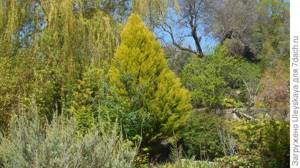
The “Achilles heel” of cypress trees is spring burns. It is better to plant them in partial shade, shading them as much as possible with various devices, including shields with burlap.
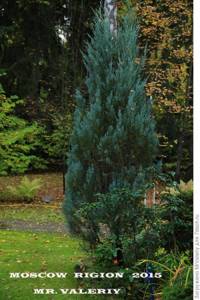
Cypress and yew trees have long endured winter freely in the Moscow region. Free until 27! Grows in a sunny place. They don't like shade and partial shade! One thing you have to do with a cypress tree is to cut off the top, since it quickly grows to the top and bends under the snow. The photo shows that the top has already been cut (double). In winter, you also have to shake off the snow. It grows very quickly and does not require special care. All spruces and thujas rest in front of the beauty of the cypress trees. My favorite
The compact cone-shaped Elwoodi cypress is not one of the very fastidious representatives of the flora, but at home it sometimes languishes, requiring changes in care conditions. This is a popular landscape and potted coniferous plant all over the world, which was originally grown only in gardens. Elwoodi is unpretentious to natural conditions and is able to get comfortable in open ground in the Moscow region.
But the tree is comfortable at moderate temperatures; harsh winters are dangerous for it, which means that during this period it needs protection from the cold. The crown of this cypress tree tolerates decorative pruning well. The transplantation technology is simple, but due to the delicate roots, caution is required. An evergreen tree can be propagated in several ways and will decorate almost any interior or landscape.
Where does swamp cypress grow?
In nature, swamp cypress is often found along the banks of sluggish rivers. Swamp cypress also grows in the southeastern swamps of North America. The plant was brought to Europe in the 17th century, but swamp cypress came to Russia only in 1813.

In 1934, on an artificial dam in the river gorge. Sukko created a cypress grove consisting of 32 trees. Currently, Cypress Lake is considered a monument of regional significance.
Swamp cypress is able to grow in soil with high levels of humidity, in river deltas. You can meet swamp cypress in natural conditions in the Danube Delta, in Crimea. Currently, the crop is actively grown in the regions of Central Asia and Uzbekistan. The Krasnodar Territory, Kuban and the Black Sea coast of the Caucasus are also recommended for cultivation.
Planting a cypress tree in the Moscow region
Coniferous plantings prefer a place in the shade; on the sunny side of the site they need to be shaded. A very hot sun can affect the plant and the branches will begin to wither, which will greatly deteriorate the decorative appearance of the cypress tree. Reproduction can be done by shoots, cuttings, and seeds. Cypress loves water, but high humidity affects the decorative properties of the plant, so everything should be in moderation.
The soil for cypress must contain many minerals, so care must be taken to enrich it. To do this, you need to add sand and deciduous soil in equal proportions, add twice as much humus and a little peat. Mix everything thoroughly and begin planting. Provide the bottom of the planting hole with drainage material, such as sand and crushed brick. Do not forget also about loosening the soil, it has a very good effect on the passage of air and moisture, without which not a single plant will survive.
An indoor cypress tree can be used as a beautiful New Year's tree. To do this, it is necessary to ensure normal conditions - sufficient humidity and coolness. If you decide to plant a cypress tree in the Moscow region, choose a frost-resistant type of this plant, as the likelihood that it will take root is much greater than that of other varieties.
Swamp cypress in landscape design
Swamp cypress is considered a valuable forest species; recently, the exotic tree is increasingly used in landscape design as a park plant. It is ideal for decorating ponds and forming park alleys. Swamp cypress will feel comfortable in swampy, flooded areas, in oxygen-depleted soil.
In combination with swamp cypress, Virginia juniper, beech, cedar, ferns, sequoia, oak, maple, linden, hops, birch, willow and pine look good. It is not recommended to plant the plant next to larch. When forming a coniferous composition, it should be oriented in a western or eastern direction.
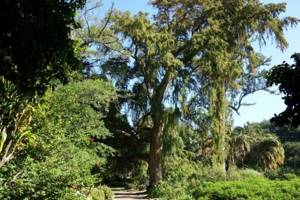
Cypress wintering in the Moscow region
Contents1 Technical side2 How to make2.1 Making doors2.2 Installing a hinge in a groove2.3 How to design2.4 Restoration and modernization2.5 How to insulate a refrigerator under a window3 How to seal4 Remove a Khrushchev refrigerator5 Improving a Khrushchev refrigerator6 Making a useful cabinet out of a Khrushchev refrigerator7 Glazing instead of a Khrushchev refrigerator8 Video : example of work on arranging a niche under a window in a “Khrushchev”9 Interior decoration9.1 Electric heating of the refrigerator10 Door finishing10.1 […]
Garden
Box for storing potatoes on the balcony in winter
Contents1 Proper storage of potatoes on the balcony in winter2 Safe storage of vegetables on the balcony in winter3 Tips: how to store vegetables on the balcony in winter4 Making a box for potatoes on the balcony with your own hands5 Tips: how to store potatoes on the balcony in winter (video)6 Features of storing potatoes on the balcony in winter7 How to make a box for storing potatoes in winter7.1 How to make a potato storage box […]
Garden
DIY vegetable box made of wood
Contents1 How to assemble a box on your own1.1 Option 1 - a simple box1.2 Option 2 - a box for a balcony1.3 Option 3 - multi-purpose structures2 Conclusion3 Necessary tools and equipment4 Instructions for making a wooden box5 Assembling a wooden box6 Wooden box as a flower pot7 General information8 Properties wooden box9 Boxes in the house10 Why wood?11 Making boxes: […]
Garden
Who owns a barley seed in a flower pot?
XI city open Olympiad for students of primary urban district - Volzhsky 2011 Literary reading. Grade 3 Remember, victory comes to those who are persistent! Task 1. Each expression has its own meaning. Most often it is direct, but sometimes it is figurative. Read the expressions. Find and underline expressions that have a figurative meaning. Heart of stone, poisonous bite, ravenous appetite, callous […]
Garden
Ash furniture color photo
Contents1 Shades of Shimo Ash2 Similar shades3 What is Shimo Ash used for?4 What shades does it combine with?5 Furniture Shimo Ash in the interior6 How shades of ash are used in the interior7 How to combine ash-colored floors and doors in an apartment8 Furniture in Shimo Ash color in the interior9 What is the best color to combine with ash10 Ash-colored furniture in the interior11 Light ash – […]
Planting and caring for swamp cypress
Despite the fact that taxodium loves light and needs bright light in winter, it needs light partial shade in hot summer. For planting swamp cypress, the south side of the site would be a good choice. The tree quickly grows to a large size, so the seating area should be quite spacious.
Preference should be given to moist soil; taxodium can be planted in an area next to a small lake or pond. In such conditions the plant will feel most comfortable. Planting is done in the spring, before the buds begin to bloom on the trees.
Preparing seedlings and planting area
Swamp cypress is quite picky about the composition of the soil. It requires well-moistened and nutrient-enriched sandy loam soil with a neutral acidity level. Taxodium does not like lime. The ideal soil mixture is:
- from 2 parts of humus;
- 2 parts of turf;
- 2 parts peat;
- 1 part river sand.
Caring for mature plants
In the first years of life, cypress needs frequent feeding (every 2-3 weeks). A mixture of mullein (5 kg of manure infused in 20 liters of water) and superphosphate is ideal for these purposes. After 4 years of life, the need for fertilizing decreases, and it will be sufficient to apply fertilizer in spring and autumn at the end of the season.
Watering should be frequent, but not abundant; by autumn, their frequency should be reduced. On hot days, cypress needs evening sprinkling, otherwise its crown loses its decorative effect due to the appearance of yellowed needles.
Formative pruning, as a care activity, is carried out in early spring, while cutting out dry and broken branches.
In winter, the trunk circles of adult plants are additionally insulated with pine needles, spruce branches or sawdust. Until the age of 4, the cypress is completely covered.
In open ground, cypress is resistant to diseases and pests, unlike indoor cultivation.
Lusitanian or Mexican cypress – Cupressus lusitanica
Reproduction
In nature, reproduction of swamp cypress is carried out through seeds. In a summer cottage, taxodium is, as a rule, more often propagated by cuttings and grafting. However, the best option is to buy ready-made seedlings in special containers. Transplantation to a permanent place should be done only at a young age, since taxodium is characterized by rapid growth of the taproot.
When planting seeds for hardening, it is worth stratifying them. To do this, they must be placed in the refrigerator and stored at a temperature of +1 to +5 o C for 2 months. To sow seeds, peat, river sand and forest litter are mixed in equal parts. The depth of the seed box must be at least 15 cm, otherwise the taproot begins to bend as it grows, and this leads to the death of the plant. After a few years, the seedlings will be ready for transplanting.
Cypress propagation: seeds and cuttings
Purchasing ready-made cypress seedlings is quite problematic and expensive, and no one can guarantee the high quality of such planting material. Therefore, independent reproduction remains relevant.
Full maturity cypress seeds have a fairly high germination rate, but require preparation before sowing. Cypress forms its first cones in adulthood after 4-5 years of cultivation. Both male and female cones appear on the same plant. The cones ripen only in the second year, so to harvest seeds you need to take not young green cones, but mature brown-gray ones.
The collected seeds must be stratified by placing them in the refrigerator for 3 to 4 months. The day before planting, the seeds are soaked overnight (at least 10 hours) in warm water. Sowing is carried out in a special mixture for coniferous species, which can be bought at any flower shop. You can use a seedling box as a container. A drainage layer of crushed deciduous tree bark is placed at the bottom of the box, and then the soil mixture is filled in.
Caring for the crops consists of regular watering; the substrate should always be moistened. Shoots appear no earlier than in a month. Seedlings grow slowly. When they reach a height of 6 cm, it is necessary to plant them in separate pots of small diameter. When replanting, you need to ensure that the root collar does not remain buried in the substrate. The first year, seedlings are grown as indoor plants, but for the winter it is better to place the pots in cooler places (veranda of a private house, loggia).
In the second year, grown seedlings can be planted in open ground, but two to three years of indoor maintenance are also allowed to obtain a stronger and more mature plant.
Cypress cuttings can take place in 3 periods:
- from mid to late April;
- end of June;
- first week of September.
For cuttings, you should take branches from the very top, cutting them off at the “heel”. Before soaking the cuttings in a growth regulator, you need to remove their lower modified needles. The treatment lasts a day, after which the cuttings are planted in a substrate similar to that used for sowing seeds. The only difference is that a thin layer of wet river sand is laid on top. The cuttings are buried 1/3 of their length and covered with glass or thick film. It is recommended to ventilate the planting for an hour every few days. Rooting lasts about 2 months, after which a full-fledged seedling can be planted in open ground.
Arizona cypress – Cupressus arizonica 'FASTIGIATA'
